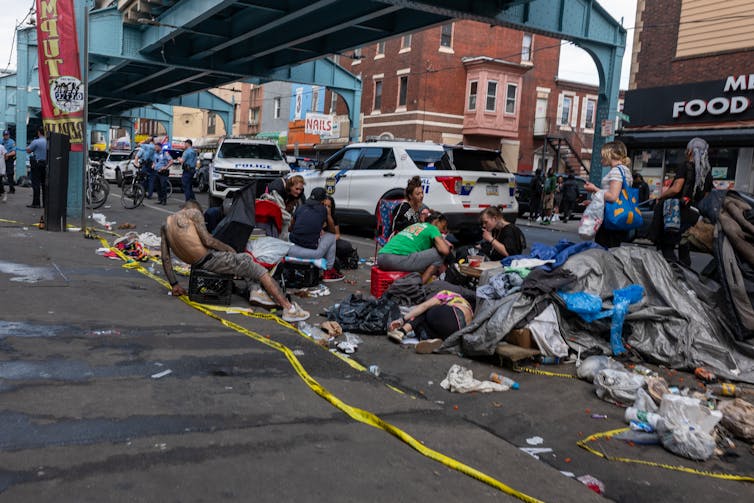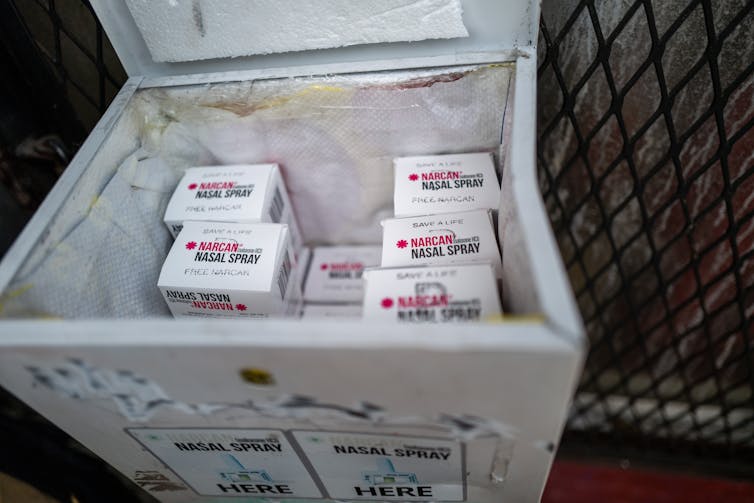Some residents of Fairmount, an upper-middle-income neighborhood of Philadelphia, are irate that a nearby homeless shelter is being turned into an addiction “triage” center without input from the surrounding community. News of the shelter’s expansion came just a week before the high-profile closing of an encampment of people experiencing homelessness and addiction in Kensington, a North Philadelphia neighborhood that has long been the center of the region’s opioid crisis.
Neighbors quickly started a petition to halt the triage center project, and they garnered over 1,100 signatures. At a contentious community meeting, they expressed fears of their neighborhood becoming “Kensington 2.0.”
As professors of political science and public policy, we have studied public opinion about opioid treatment policies in the U.S. Our research shows that while Americans acknowledge the general need for opioid addiction treatment facilities, they don’t like these services to be located near where they live. This “not in my backyard” – or NIMBY – opposition is true for people across the ideological spectrum.
We have also found that whether people support expanded opioid treatment policy spending or not can depend on whether they share a racial identity with the people they see might benefit from that policy.
We conducted a series of experiments and gathered survey data from both urban and rural respondents across the country to understand how both of these dynamics shape opposition to opioid treatment policies.

Role of race and media
In one experiment, we asked both white and Black respondents to read a media profile of someone struggling with opioid addiction. We randomly varied aspects of the profiled individual’s identity, including whether they were white or Black, male or female, or lived in an urban, suburban or rural area.
We found that both white and Black respondents were more supportive of funding treatment programs after reading a profile about someone who shared their racial identity. We did not find similar effects based on shared gender or geography.
Our findings, published in the March 2024 issue of the peer-reviewed journal Political Behavior, suggest that race remains a dominant cleavage in shaping public attitudes toward opioid policy.
As a result, the way that media outlets depict people struggling with addiction could affect support for these policies. For example, evidence increasingly shows that overdose rates among Black Americans are rising faster than rates among white Americans, which could lead to a decrease in public support for opioid treatment policies among white Americans. Media coverage that emphasizes how the opioid crisis affects both white and Black communities may avoid this backlash.
Finding common ground
In addition to race, our research shows an individual’s income and how opioid treatment policies are funded also affect people’s support.
In an earlier study we did, we asked respondents whether they supported a US$100 million state bill to respond to the drug epidemic. However, we randomly varied the structure of the bill.
Half our respondents saw a “redistributive” bill, where residents with a household income greater than their state’s median income would pay $55, and those below the median income would pay $5. The other half of our sample saw a “need-based” bill, where respondents living in areas with high opioid overdose rates would pay $55, and those in areas with low overdose rates would pay $5.
Respondents across the board preferred the redistributive bill compared to the need-based bill. This shows that Americans are willing to chip in rather than leave struggling communities to foot the bill on their own.
While higher-income Republicans showed little support for a redistributive funding bill, lower-income Republicans supported it.
Given that Democrats across the income spectrum supported the redistributive funding bill, our research suggests the potential for a coalition between Democrats and lower-income Republicans. Policymakers could take advantage of this to enact popular policy to address the crisis.

Building treatment
Even with this broad support, however, funding may have a limited effect if there aren’t more opportunities to build outpatient treatment centers and inpatient residential programs.
For example, addiction researchers have found that one of the most effective ways to respond to the opioid crisis is through medication-assisted treatment, such as methadone. Methadone treatment can require daily visits to a clinic for the first 90 days. Therefore, those seeking help must have reasonable access to a nearby clinic.
We asked survey respondents whether they supported opening a new methadone clinic, but randomly varied whether the clinic was either a quarter-mile away from their home, about a five-minute walk, or two miles away, about a 40-minute walk. While Democrats showed greater average support for clinics, both Democrats and Republicans showed 15 percentage points less support when the clinic was sited just a five-minute walk away.
Overcoming opposition
NIMBY attitudes across the political spectrum can impede construction of new opioid treatment facilities wherever they are proposed. However, we believe innovative policy solutions can help to prevent this.
State and local policymakers can take cues from the federal government’s military base closure strategies, for example. Rather than voting on base closures one at a time – a strategy that would enable local opposition to block each closure – Congress has to decide on a single bundle of closures determined by an independent commission. This bundling spreads the spatial impact of the policy in a fair way.
Given that residents in cities like Philadelphia typically support opioid addiction treatment centers in theory, political leaders can harness this support but require infrastructure to be geographically spread out – and not just in the areas of the city where political opposition is less acute.

